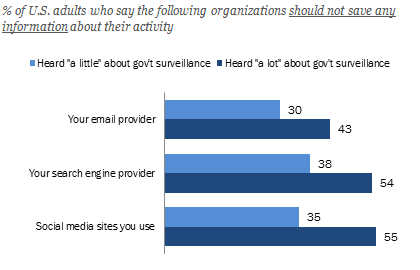You and I may have a hard time believing it, but many people are afraid to shop online.
Now, as someone who regularly makes ridiculous impulse purchases, I never second guess entering my credit card information online.
In fact, I just bought a Led Zeppelin coffee mug in the time between writing and editing this article. You, too, probably regularly buy books, movies, clothes, and software online.
But that doesn’t mean all of your potential customers are comfortable with it.
It’s Not Just You: Consumers Have Security Concerns
A recent study by the Department of Commerce found that half of American Internet users are “deterred” from buying things online because of fears over privacy and security.
Without any prompting, 84% of online households named at least one concern they had about online privacy and security risks, and 40% cited at least two different concerns.
This study was published in 2016, but it seems not much has changed since 2015, when another study by Connexity (n=4,902) found that many people were afraid to purchase online.
In their research, there was a large variation in how different age groups responded (older people being less trusting), as well as some surprising differences in where people feel most worried about privacy/security breaches:
And the four most common reasons for people’s distrust:
- “News reports of information being stolen from retailers” (43%),
- “My information was stolen” (17%),
- “I don’t believe that the store will take good care of me if there is a problem” (12%)
- “I tend not to trust companies, employees or technology” (10%)
A 2014 study of 10,000 people found an even higher percentage of people were worried about e-commerce transactions:
You can see that a large amount of this is outside of your sphere of control. However, 12% of people don’t believe your particular store will take care of them. You can solve that. And 10% don’t trust companies/tech/etc. You can also bolster up your trust signals.
While the Department of Commerce study found 26% of households won’t purchase at all online, 29% were wary about doing so. Wary is convert-able. Wary just requires some effort and tact on your part.
Online Shopping and Privacy Concerns
It’s clear that people are worried about security breaches and identity theft, but they’re also worried about privacy and what you’re doing with their data.
According to Pew Research (2015), 93% of adults say that being in control of who can get information about them is important, and 90% say that controlling what information is collected about them is important. Another study actually found people are more concerned about online privacy than they are about losing their main income.
In general, people believe keeping control of their information and privacy is important.
Yet few trust that their information will remain private…
The issue of data privacy gains salience as data collection and analysis becomes more sophisticated and less costly. There’s hardly a day that goes by without seeing at least one reference in the news about government surveillance, or at least Facebook privacy backlash.
And one of the biggest struggles with personalization is toeing that line between creepy and effective. Nobody wants their data abused, but at the same time, people like relevant ads and online experiences.
Anyway, this article won’t go into great depth on such a complex subject. It’s enough to know that, because of issues outside of your control, people are cautious about handing over their information – personal or financial.
Digitalist Magazine summed it up well when they said, “The next challenge for e-commerce will be to create an environment of trust that maintains a level of personalization. Because everyone knows that a security breach is bad for business.”
Let’s keep it practical: what can you do to make people less afraid – less hesitant – to shop on your website?
6 Ways to Solve People’s Fear of Online Shopping
You can’t do much about security breaches at Paypal or mishandling of data at other companies or the government, but you can make your site more trustworthy.
First off, you need to know what, specifically, is making your customers nervous. Of course, there are some things – design and otherwise – that are unconscious, and therefore, won’t be brought up. But a solid way to find certain aversions and worries is to use an on-site survey and ask, “Is there anything holding you back from making a purchase today?”
Once you have some feedback, you can outline some patterns and create some possible fixes. It’s sort of an art – there’s no silver bullet solution.
However, there are some best practices, some things that usually work to bolster trust on your site. These are things you can test and iterate upon as well. Here are 6 things that usually allay fear:
1. Make Your Business Look Real
According to SiteJabber, one of the most common concerns people have with online shopping is whether or not the store is actually real.
While that seems crazy to me, it’s a concern to many people. Alex McEachern wrote a post on Sweet Tooth Rewards where he outlined reasons people are afraid to buy online.
To do this, he used his sister, a skeptical consumer, as an example. According to him, her number one concern is whether or not she’s dealing with a real store. As he put it, “When asked why, she states that anyone can setup a website and it is much easier for fraudulent activity to occur online than in person.”

Something seems off here. (Image Source)
How do you assure your customers that you’re actually real? Well, preceding reputation helps. If you’ve been written about in TechCrunch or your customer is finding you via genuine word-of-mouth, it’s an easier battle to fight.
But no matter who is landing on your site, investing in better, more credible design will help your chances of converting them.
According to a Stanford study, 46% of site visitors assess your site’s credibility on the look of the homepage.
So would you trust a site that looked like this?
The first thing I think when I see this is “take my money” – and not in the good Futurama meme way, more like they’re literally going to steal my money.
If you have a sketchy design, it’s hard for any amount of social proof, trust symbols, live chat, etc., to convince someone otherwise. You’re starting from a point of negativity. You’re in the hole before you even begin persuasion tactics.
So what I would do is reverse-engineer those sketchy sites, and do the opposite of what they do.
- Have an About Page. Put your smiling faces on it.
- List your contact information – prominently.
- Answer the phone/support chat when people want to talk.
- List your company location.
- Make it easy to verify the accuracy of the information on your site (more on that below).
- Design your site so it looks professional (or is appropriate for your purpose).
- Use restraint with promo elements. Focus on the UX first.
- Fix your grammar mistakes.
CRO expert Jeremy Smith wrote about this, too:
 Jeremy Smith:
Jeremy Smith:
“Ever been to an e-commerce website that looks like a refugee from the early ’90s? One of those sites with poor design, little content and lots of ads?
When I visit sites like that, I immediately suspect that something scammy is going on – and there’s no way I’m going to part with any cash. Many consumers feel the same. That’s why it’s important to address some of the subtle and not-so-subtle cues that can allay that fear. That means: Looking after web design, making sure your site is clear and makes it easy for people to shop.”
2. Live Chat/Real-Time Support
I’m a big fan of live chat. So, it appears, are many millennials. A Software Advice study on live chat showed:
- Over half (56 percent) of respondents have used live chat at least once to answer a question on a company’s website.
- Forty-nine percent of respondents prefer using live chat for online-shopping questions, while 74 percent prefer telephone for complex financial questions.
- Regardless of the nature of the question, 56 percent of respondents aged 18 to 34 prefer live chat to phone, compared to 27 percent of respondents aged 35 and older.

It also showed that the most appealing part of live chat was the lack of wait times. People want answers and they want them in real-time.
An FAQ page is okay, but to answer questions, doubts, fears, and hesitations as they arise is a real superpower when it comes to e-commerce.
I know, for instance, there have been many times I’ve had silly questions while shopping online and I always – always – look for a live chat feature before anything else. I don’t want to wait for email. Next best would be a phone number (if the question is of enough importance).
 Charles Schwab uses reactive live chat.
Charles Schwab uses reactive live chat.
But the point is, real-time customer service can do wonders to allay fear and increase conversions (and repeat purchases).
3. Trust Symbols
Alright, so if you’ve ever read a blog post on conversion optimization, you probably know all about trust symbols.
That study from Connexity I mentioned above? They mentioned that most of the people who are worried about online shopping look for trust symbols:
“Of those worried about online, 69% say they look for web sites that display trust symbols, such as those from Bizrate Customer Certified, TRUSTe and the Better Business Bureau. Women are more likely than men to look for these symbols given to retail sites that meet certain security criteria, but there was little variation by age.”
If your audience tips towards the ‘neurotic’ side of the online shopping sliding scale, trust symbols are of extra importance.
Of course, there are no shortage of case studies purporting that trust symbols lift conversions (and a few that say removing them increases conversions, too – but hey, that’s the CRO world).
In general, whatever you can do to increase the feeling of trust and safety on your site, you should do. Nobody wants to feel like they’re going to be ripped off, or that their personal and financial information will be unsafe.
A few common trust symbols include:
- McAfee
- Verisign
- Paypal
- BBB
- TRUSTe
4. Product Guarantees
I just saw a Reddit thread the other day that perfectly illustrated the power of a money-back guarantee. Some person bought Tai Lopez’s product basically because, screw it, there’s a money-back guarantee:

Now, it appears that, in this particular case, Mr. Lopez isn’t keeping his promise. So, if you’re going to offer a money-back guarantee, 1) have a product that doesn’t suck and 2) commit to your guarantee.
Basically, don’t use guarantees as a slimy sales tactic, but rather as a confident and honest bet on the quality of your product.
Usually, guarantees work.
As Peep wrote, “Whenever there’s a transaction, there’s risk. Usually the vendor has the buyer carry most of the risk. If the risk seems to big, the purchase won’t take place.”
As long as your customers believe in your guarantee and you follow through with it, it will help remove that risk. Some examples:
- Hyundai struggled for years with a reputation that it makes crappy cars that break down fast. So they initiated a 10-year warranty – basically saying that ‘how can it be a bad car if we’re giving it such a long warranty?’
- Pizza delivered in 30 minutes or it’s free.
- Not only will we give your money back, but also compensate your pain. This is the most powerful kind of guarantee – a pain compensation guarantee.
30-day money-back guarantee is the industry standard, and you should definitely not offer any less. Try to do better than that.
And you can A/B test various guarantees to find out what works best for your site.
5. (Social) Proof
When you’re in a mall, you can see how crowded a store is to infer its popularity (a proxy, generally speaking, for quality). Online, you, as the business owner, have to provide these social signals.
When shopping online, we want proof. We want to know everyone else got good value from your products. Here’s what Jeremy Smith has to say about social proof and its ability to assuage the nerves of careful shoppers:
 Jeremy Smith:
Jeremy Smith:
“For researchers, there’s only one thing that matters – other people’s opinion, or social proof. This helps them decide whether they are likely to like the product too. If a product gets a dozen bad reviews, your typical online researcher will ignore it forever. But if there’s a balance of positive and negative reviews, the typical shopper will do some more research.”
Whatever you claim, you need to back it up with proof. People are skeptical and they want to see the evidence.
So what kind of proof can you provide?
- Customer testimonials – people who used your products verify your claims.
- Case studies – before and after customer journeys that show how your product changes lives for the better.
- Research and studies. Duolingo’s validity has been supported by multiple independent studies, creating a more empirical type of proof.
- Third-party reviews – Did a trade magazine or a blog write a glowing review? Tweets, Yelp, etc. also fit in here.
- Social proof by the numbers – If you have thousands of customers, make it a well-known fact. Nobody wants to be the only idiot using your service. If you have thousands of people/companies using your service, it can’t be all that bad!
6. Product Previews/Trials
People like to try things, or at least get a feel for the value, before they lay down their cash to purchase. That’s the allure of shopping in real life – you get to physically see, feel, and try out the product.
That’s also why free trials and freemium versions exist in SaaS (or at least a good demo).
While we now think of software companies when we think of product trials, the original “try before you buy” came in the form of clothing store changing rooms.
With e-commerce, however, there’s no way to tell if that pair of jeans you’ve got your eye on will actually fit well. And returning can be a hassle (especially when a site doesn’t have a clear guarantee/return policy). For that reason, many sites are implementing a “try-before-you-buy” strategy as well.
Check out this ad I saw on my Instapaper weekly newsletter:

A t-shirt company that lets you try it first. Interesting. This is a newer service, but Warby Parky is one of the OG’s of the try-it-first method:

Trunk Club, too, is one of the originals. They send you a custom box of clothing and only charge you for the things you choose to keep:

Try.com also claims to let you try on clothes before you actually pay for them:

The question is: how do you reduce perceived risk for the customer? If you can take it away entirely – by offering a try-before-you-buy plan and a money-back guarantee – you’re certainly reducing the friction as well as the fear inherent in some customers’ online shopping experiences.
Conclusion
Many people are still afraid to hand over their credit card online. While you can’t very well control the collective fear of a population, you can do what is within your control to assuage the fears of your own visitors.
This post outlined 6 strategies to boost trust and decrease fear and aversion on your website:
- Make your business look real
- Real-time support / live chat
- Trust symbols
- Product guarantees
- Social proof
- Trials / Try before you buy
Digital & Social Articles on Business 2 Community
(84)













